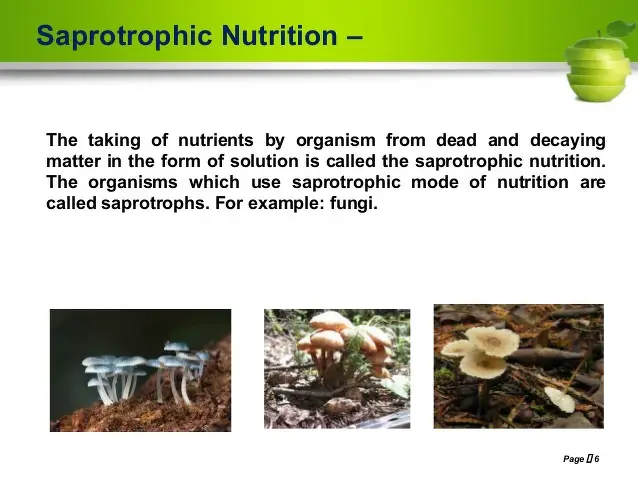Saprotrophic mode of nutrition is when an organism obtains nutrients from decaying organic matter in its environment. This process involves the breakdown of dead plant and animal material by fungi, bacteria, and other microorganisms to obtain nutrients for their own growth and development.
Saprotrophic organisms play an essential role in the ecosystem by breaking down organic matter, facilitating nutrient cycling, and returning essential elements back to the environment. Through the process of decomposition, saprotrophs contribute to the enrichment and fertility of soil, allowing for the growth of new plant life.
This mode of nutrition is fundamental for the breakdown of complex organic compounds, releasing nutrients such as nitrogen, carbon, and phosphorus back into the environment, supporting the overall balance and sustainability of the ecosystem. Understanding the saprotrophic mode of nutrition is crucial for comprehending the interconnectedness and interdependence of living organisms within natural systems.

Credit: www.youtube.com
Characteristics
Saprotrophic mode of nutrition is characterized by organisms that obtain nutrients by breaking down dead organic matter. Bacteria, fungi, and some protests are involved in this process.
The process of decomposition involves the breakdown of complex organic substances into simpler compounds that can be absorbed by saprotrophs. In this way, nutrients are recycled into the ecosystem.
Credit: en.wikipedia.org
Advantages And Disadvantages
Saprotrophic nutrition is a type of feeding strategy observed in fungi, bacteria, and certain other organisms. It involves the breakdown of dead or decaying organic matter to obtain nutrients. This mode of nutrition offers several advantages. Firstly, it aids in the recycling of nutrients, ensuring that valuable substances are not wasted. Moreover, saprotrophic organisms play a crucial role in decomposing organic matter and enriching the soil with essential elements. Additionally, this type of nutrition requires less energy expenditure compared to other modes. It also allows organisms to thrive in diverse environments, as their feeding source is readily available. However, there are also limitations to saprotrophic nutrition. One limitation is the inability of saprotrophs to break down complex substances such as cellulose or lignin. Furthermore, competition for resources can be fierce, particularly in densely populated ecosystems.
Role In Ecosystem
Saprotrophic mode of nutrition plays a crucial role in ecosystem by aiding in nutrient recycling. Organisms involved in saprotrophic nutrition decompose dead organic matter, releasing nutrients back into the soil for uptake by plants. This process ensures the continual cycling of essential nutrients for the sustenance of life within the ecosystem.
Moreover, the impact on biodiversity is significant, as the decomposition of organic matter by saprotrophs creates diverse microhabitats. This diversity supports a wide array of plant and microbial species, contributing to the overall richness and resilience of the ecosystem.
Comparison With Other Modes
Saprotrophic mode of nutrition is a process of obtaining nutrients by decomposing organic matter. In contrast with autotrophic nutrition, saprotrophic organisms do not photosynthesize.
Contrast with Autotrophic Nutrition
Unlike autotrophs, saprotrophs rely on external sources of organic matter for sustenance.
Differences from Parasitic Nutrition
Saprotrophs decompose dead organic material, while parasites feed on living organisms, often damaging their hosts.
Examples In Nature
Fungi as Saprotrophs: Fungi are prime examples of saprotrophic organisms. They obtain their nutrients by decomposing organic matter. This includes dead plants, animals, and even waste products. Fungi secrete enzymes that break down complex organic compounds into simpler substances, allowing them to absorb the necessary nutrients. They play a crucial role in the ecosystem by recycling nutrients back into the environment.
Bacteria and Saprotrophic Nutrition: Bacteria also exhibit saprotrophic nutrition. They break down organic matter through the process of decomposition, releasing nutrients that can be used by other organisms. Bacteria have the ability to break down a wide range of organic compounds, including carbohydrates, proteins, and fats. This makes them important contributors to nutrient cycling in various ecosystems.
| Organism | Nutrition Mode |
| Fungi | Saprotrophs |
| Bacteria | Saprotrophs |
Human Interaction
Saprotrophic mode of nutrition involves fungi breaking down organic matter to obtain nutrients. Through enzyme secretion, fungi decompose and absorb nutrients from dead plant or animal material. This process is crucial for nutrient recycling in ecosystems and plays a vital role in organic matter decomposition.
| Saprotrophic Mode of Nutrition |
| In nature, saprotrophic organisms break down decaying matter through extracellular digestion. This process aids in recycling nutrients back into the ecosystem. Relation to composting: Saprotrophs play a vital role in decomposing organic matter in compost heaps. Applications in waste management: Utilizing saprotrophic organisms can accelerate the decomposition of waste, promoting sustainable environmental practices. |

Credit: pt.slideshare.net
Frequently Asked Questions Of What Is The Saprotrophic Mode Of Nutrition?
What Is Saprotrophic Nutrition And How Does It Work?
Saprotrophic nutrition is a process where organisms obtain nutrients from decaying organic matter. Fungi and some bacteria use enzymes to break down dead tissue and absorb the resulting nutrients.
What Are Some Examples Of Saprotrophic Organisms?
Common examples of saprotrophic organisms include fungi like mushrooms, mold, and yeast. Additionally, certain types of bacteria also exhibit saprotrophic nutrition, helping to break down organic matter in the environment.
How Do Saprotrophs Contribute To Ecosystem Balance?
Saprotrophic organisms play a crucial role in ecosystem balance by breaking down dead organic matter, recycling nutrients, and returning them to the environment. This helps maintain soil fertility and supports the growth of new plants and organisms.
Why Is Saprotrophic Nutrition Important In The Natural World?
Saprotrophic nutrition is important because it facilitates the decomposition of dead organisms and organic waste, recycling nutrients back into the environment. This process is vital for maintaining the health of ecosystems and supporting the growth of new life.
Conclusion
The saprotrophic mode of nutrition is a fascinating process where organisms obtain nutrients by decomposing dead organic matter. They play a crucial role in recycling nutrients, maintaining ecological balance, and contributing to soil fertility. Understanding this mode of nutrition helps us appreciate the intricate relationships within ecosystems and the essential role that decomposition plays.
So, next time you stumble upon decaying leaves or fallen trees, remember the important work of saprotrophs in nature’s grand scheme.











